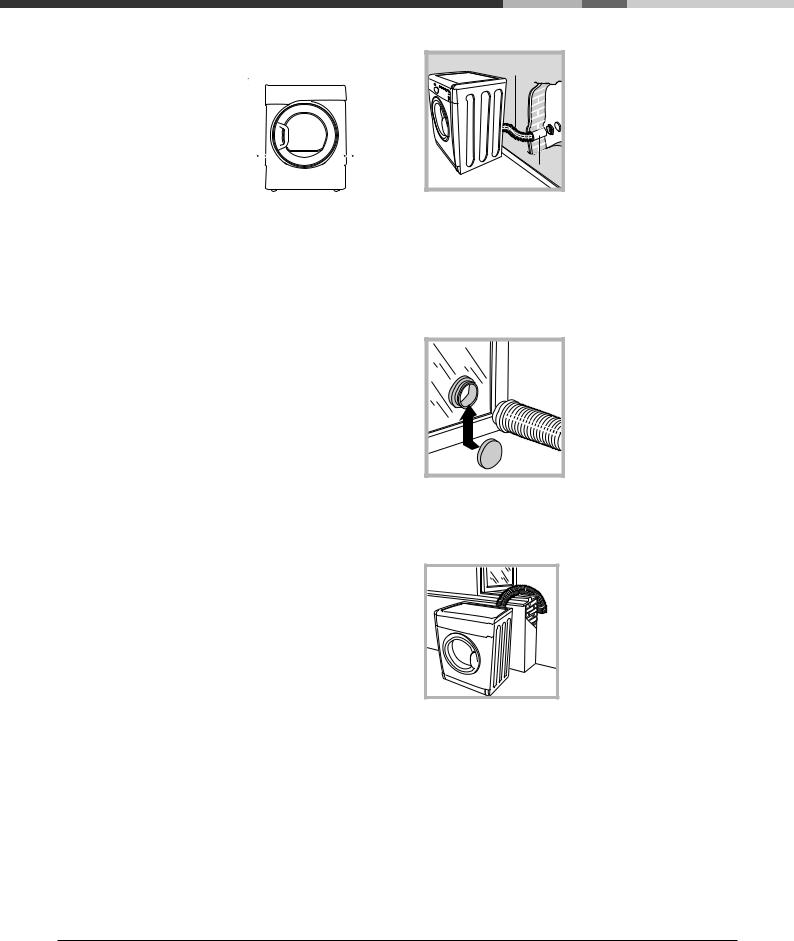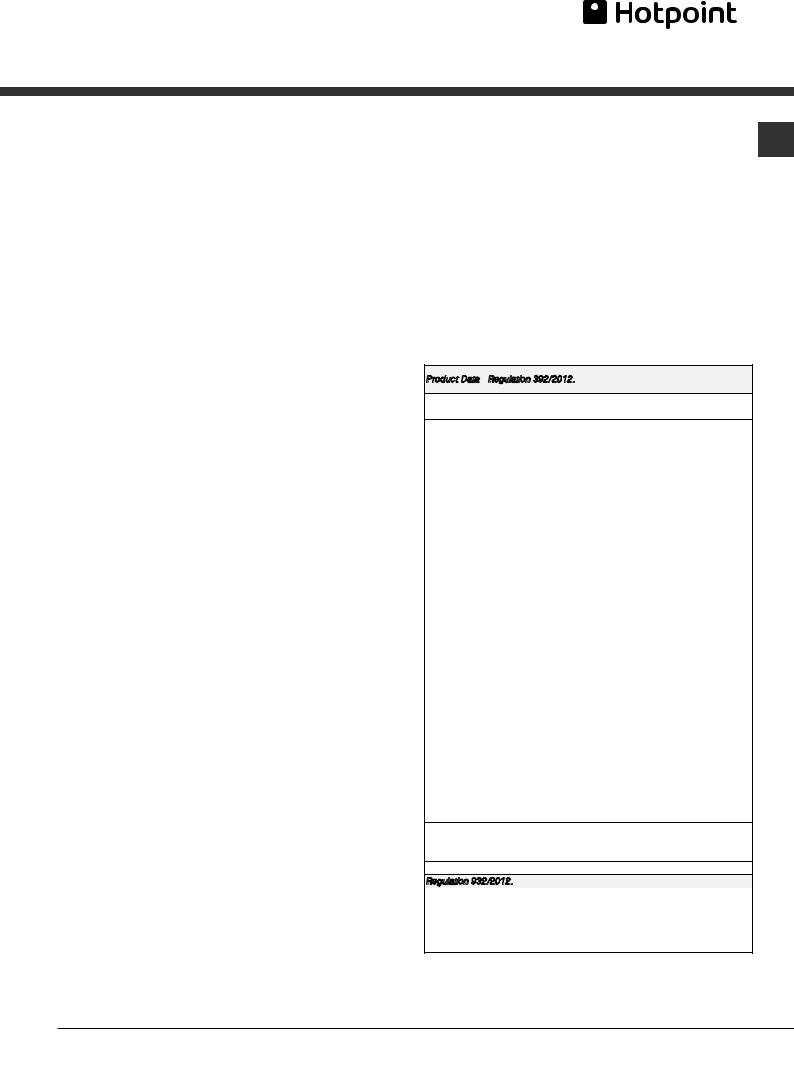Hotpoint Ariston TVFS 83C GP User Manual

Instruction manual
TUMBLE DRYER
EN
English
TVFS 83C
Contents
GB
Installation, 2
Where to install the tumble dryer Ventilation
Electrical connections Levelling the tumble dryer Before you start your dryer
Warnings, 4
General safety
Saving energy and respecting the environment
Care and maintenance, 6
Disconnecting the power supply Cleaning the filter after each cycle Checking the drum after each cycle Cleaning the tumble drye
Description of the tumble dryer, 7
Features Control panel
How to carry out a drying cycle, 10
Starting and selecting a programme
Programmes and options, 11-12-13
Programme chart Special programmes Options
Opening the door
www.hotpoint.co.uk
!This symbol reminds you to read this instruction manual.
!Keep this manual at hand for immediate reference whenever
necessary. Always store this manual close to the tumble dryer and remember to pass it on to any new owners when selling or transferring the appliance, so they may familiarise with the warnings and suggestions herein contained.
! Read these instructions carefully: the following pages contain important information on installation and useful suggestions for operating the appliance.
Laundry, 14
Sorting laundry Care labels Drying times
Troubleshooting, 15
Assistance and Guarantee, 16
Spare parts
Information on recycling and disposal
To activate you free* 5 years parts guarantee
Call free on 0800 519 2102
*Labour charges not included. Terms and conditions apply. Lines open 364 days a year. Calls are free from a BT landline. Charges from other providers and mobiles may apply.
1

Installation
|
Where to install the tumble dryer |
|||||||||||
GB |
||||||||||||
• Install the dryer far |
|
|
|
|
|
|
|
|
|
|
||
|
|
|
|
|
|
|
|
|
|
|
||
|
from gas ranges, stoves, |
|
|
|
|
|
|
|
|
|
|
|
|
mm |
|
|
|
|
|
|
|
|
|
||
|
|
|
|
|
|
|
|
|
|
|||
|
radiators or hobs, as |
|
|
|
|
|
|
|
|
|
||
|
flames may damage it. |
10 |
|
|
|
|
|
|
|
|
|
|
|
|
|
|
|
|
|
|
|
|
|
||
|
If the dryer is installed |
|
|
|
|
|
|
|
|
|
|
|
|
below a worktop, ensure |
|
|
|
|
15 mm |
15 mm |
|
|
|||
|
there are 10 mm betwe- |
|
|
|
|
|
|
|||||
|
|
|
|
|
|
|
|
|
|
|
||
|
en the upper panel of the |
|
|
|
|
|
|
|
|
|
|
|
|
dryer and any objects |
|
|
|
|
|
|
|
|
|
|
|
|
|
|
|
|
|
|
|
|
|
|
||
|
above it, and 15 mm |
|
|
|
|
|
|
|
|
|
|
|
|
between the sides of the machine and the |
|||||||||||
|
walls or furniture units adjacent to it. This en- |
|||||||||||
|
sures adequate air circulation. Make sure the |
|||||||||||
|
air inlets on the rear panel are not blocked or |
|||||||||||
|
obstructed. |
|
|
|
|
|
|
|
|
|
|
|
•You should also make sure that the room in which the tumble dryer is installed is not damp, and that it is adequately ventilated.
•! We do not recommend that the dryer is installed in a cupboard but the dryer must never be installed behind a lockable door, a sliding door or a door with a hinge on the opposite side to that of the dryer door.
•! The appliance must be installed with the rear surface placed against a wall.
Ventilation
This appliance gently dries laundry by taking in cold, clean and relatively dry air, heating it and passing it through the fabric. To facilitate the drying process, damp air is expelled at the rear, through a ventilation hose. When the dryer is in use, there has to be adequate ventilation to avoid a back flow
of gases into the room from appliances burning other fuels, including open fires.
Mobile ventilation system
When using the tumble dryer with the mobile ventilation system, a ventilation hose must be connected. The hose should be securely fastened to the ventilation hole at the rear of the appliance (see “Description of the tumble dryer”). We recommend the hose is connected to an outlet near the tumble dryer, if possible. If it cannot be installed in a permanent spot, the tumble dryer will still function perfectly well if the ventilation hose is passed through a partiallyopened window.
!Make sure you do not point the ventilation hose towards the air inlet, which is located on the rear of the appliance.
!The ventilation hose should not exceed a maximum length of 2.4 metres; it should also be shaken frequently to remove any fluff, dust or water deposits inside it. Make sure you do not crush the hose.
Fixed ventilation system
We recommend the ventilation hose is connected to a ventilation system for windows or doors, available from the retailer which originally sold you the appliance or from your local spare parts stockist.
Wall ventilation hole |
|
B |
1. Leave an opening in the wall |
to the left of the tumble dryer |
|
|
installation site. |
|
2. Make the hose as short and |
|
straight as possible, in order |
|
to prevent any moisture from |
|
condensing and leaking back |
A |
into the appliance. |
3. The hole in the wall must |
|
|
also be straight and pointing |
downwards, so that the flow of air coming out is not impeded.
Areas A and B should be checked frequently, to prevent the accumulation of fluff or debris, particularly if the tumble dryer is used very often. The hose adaptor must be fitted
correctly, in order to prevent damp air from coming back into the room.
Window ventilation hole
The ventilation hole should be directly behind the dryer in
order to keep the hose as short as possible.
! Make sure you do not push the tumble dryer too far backwards, as this could lead to the ventilation hose being crushed, bent or even
disconnected.
! There should be no cuts, kinks or “U”-shaped bends in the hose, as these could impede ventilation or trap condensation.
Ventilation through an open window
The end of the hose must be
facing downwards, in order to
prevent the hot, damp air from
forming condensation in the room or the tumble dryer.
!Make sure that the tumble dryer is adequately ventilated, and that the end of the ventilation hose is not pointing towards the air inlet pipe on the rear of the appliance.
!The ventilation hose must always be fitted to ensure optimum performance.
!Make sure that the ventilation hose and the air inlet vents are not obstructed or blocked.
!Do not let the tumble dryer recirculate exhaust air.
!Improper use of the tumble dryer may result in fire hazards.
!The air emitted by the tumble dryer must not be expelled in the same duct as used for the fumes produced by different appliances which burn gas or other fuels.
!Do not discharge the exhaust air into an extraction system or any duct with an extractor fan. This will affect the way the
thermal controls operate and can result in a fire hazard.
2

Electrical connections
Before plugging the appliance into the socket, check the following:
• Make sure your hands are dry.
• The socket must have an earth connection.
• The socket must be able to withstand the machine’s maximum power output as indicated on the rating plate (see Description of the tumble dryer).
• The power supply voltage must fall within the values indicated on the rating plate (see Description of the tumble dryer).
• The socket must be compatible with the dryer’s plug. Should this not be the case, replace the plug or the socket.
! DO NOT USE EXTENSION CORDS. (MAIUSCOLO)
! The dryer must not be installed outdoors, even if the space is sheltered. It can be very dangerous if exposed to rain or storms.
! Once installed, the dryer’s electrical wire and plug must be within reach.
! The power cord must not be bent or squashed.
! If the plug being replaced is a non-rewirable type, then the cut-off plug must be disposed of safely. DO NOT leave it where it can be inserted into a socket and create a shock hazard.
! The electric cord must be regularly checked. If the supply cord is damaged, it must be replaced by the manufacturer, its service agent or similarly qualified persons in order to avoid a hazard. (see Service). New or longer power cords are supplied at an extra charge by authorized dealers.
!The manufacturer denies any responsibility should any of these rules not be followed.
!If in doubt about any of the above consult a qualified electrician.
Levelling the tumble dryer
The tumble dryer should be installed level in order to operate correctly.
After installing the tumble dryer in its permanent position, make sure it is level; check its side-to-side levelling first, followed by front-to-back.
If the tumble dryer is not perfectly level, use a wooden block to support it while you adjust the two front feet, up or down as necessary.
GB
Before you start your dryer
Once the tumble dryer is installed, clean the inside of the drum before operating it and remove any dirt accumulated during transportation.
3

Warnings
! This appliance has been designed and built according to GB international safety standards. These warnings are given for
safety reasons and must be followed carefully.
General safety
•This appliance can be used by children aged from 8 years and above and persons with reduced physical, sensory or mental capabilities or lack of experience and knowledge if they have been given
supervision or instruction concerning use of the appliance in a safe way and understand the hazards involved.
•This tumble dryer has been designed for home, and not professional, use.
•Do not touch the appliance while barefoot or with wet hands or feet.
•Unplug the machine by pulling on the plug, not the cord.
•Children should be supervised to ensure that they do not play with the dryer.
•Cleaning and user maintenance shall not be made by children without supervision.
•Children of less than 3 years should be kept away from the appliance unless continuously supervised.
•The appliance must be installed correctly and have proper ventilation. The air intake vents behind the machine, the outlet vents and the vent tube should never be obstructed (see Installation).
•Never direct the vent tube outlet towards the air intake at the back of the machine.
•Never allow the tumble dryer to recycle exhaust air.
•Never use the dryer on carpeting where the pile height would prevent air from entering the dryer from the base.
•Check to see if the dryer is empty before loading it.
•The back of the dryer could become very hot. Never touch it while in use.
•Do not use the dryer unless the filter, is securely in place (see Maintenance).
•Do not overload the dryer (see Laundry for maximum loads).
•Do not load items that are dripping wet.
•●Carefully check all instructions on clothing labels (see Laundry).
•Do not tumble dry large, very bulky items.
•Do not tumble dry acrylic fibres at high temperatures.
•Do not turn off the dryer when there are still
warm items inside.
•Clean the filter after each use (see Maintenance).
•Do not allow lint to collect around the dryer.
•Never climb on top of the dryer. It could result in damage.
•Always follow electrical standards and requirements (see Installation).
•Always buy original spare parts and accessories (see Service).
To minimise the risk of fire in your tumble dryer, the following should be observed:
•Tumble dry items only if they have been washed with detergent and water, rinsed and been through the spin cycle. It is a fire hazard to dry items that HAVE NOT been washed with water.
•●Do not dry garments that have been treated with chemical products.
•Do not tumble dry items that have been spotted or soaked with vegetable or cooking oils, this constitutes a fire hazard. Oil-affected items can ignite
spontaneously,especially when exposed to heat sources such as a tumble dryer. The items become warm, causing an oxidisation reaction with the oil, Oxidisation creates heat. If the heat cannot escape, items can become hot enough to catch fire. Piling, stacking or storing oil-effected items can prevent heat from escaping and so create a fire hazard.If it is unavoidable that fabrics containing vegetable or cooking oil or those that have been contaminated with hair care products be placed in a tumble dryer they should first be washed with extra detergent - this will reduce, but not eliminate the hazard. They should not be removed from the dryer and piled or stacked while hot.
•Do not tumble dry items that have previously been cleaned in or washed in, soaked in or soiled with petrol/gasoline, dry cleaning solvents or other flammable or explosive substances. Highly flammable substances commonly used in domestic environments including cooking oil, acetone, denatured alcohol, kerosene, spot removers, turpentine, waxes and wax removers. Ensure these items have been washed in hot water with an extra amount of detergent before being dried in the tumble dryer.
•●Do not tumble dry items containing foam
4

rubber (also known as latex foam), or similarly textured rubber like materials. Foam rubber materials can, when heated, produce fire by spontaneous combustion.
•●Fabric softener or similar products should not be used in a tumble dryer to eliminate the effects of static electricity unless the practice is specifically recommended by the manufacturer of the fabric softener product.
•Do not tumble dry undergarments that contain metal reinforcements eg. bras with metal reinforcing wires. Damage to the tumble dryer can result if the metal reinforcements come loose during drying.
•●Do not tumble dry rubber, plastic articles such as shower caps or babies waterproof covers, polythene or paper.
•Do not tumble dry rubber backed articles, clothes fitted with foam rubber pads, pillows, galoshes and rubber coated tennis shoes.
•Remove all objects from pockets such as lighters and matches.
WARNING: Never stop the dryer before the end of the drying cycle unless all items are quickly removed and spread out so that the heat is dissipated.
Save energy and respect the environment
•Wring out all items to eliminate excess water before tumble drying (if you use a washing machine first, select a high spin cycle). Doing this will save time and energy during drying.
•Always dry full loads - you save energy: single items or small loads take longer to dry.
•Clean the filter after each use to contain energy consumption costs (see Maintenance).
Maximum load sizes: 8 kg
GB
Product Data - Regulation 392/2012.
Brand
Hotpoint
Model
TVFS 83C GP (UK) TVFS 83C GG (UK) TVFS 83C GK (UK) TVFS 83C GX (UK)
Rated capacity of cotton laundry for the "standard cotton |
8.0 |
|
programme" at full load - kg |
||
|
||
|
|
|
This household tumble drier is a |
Vented |
|
Energy efficiency class on a scale from A+++ (low consumption) |
C |
|
to D (high consumption) |
||
|
||
|
|
|
The weighted Annual Energy Consumption (AEc)* kWh 1) |
583.0 |
|
This household tumble drier is a |
Automatic |
|
Energy consumption full load; Edry - kWh 2) |
4.97 |
|
Energy consumption partial load; Edry½ - kWh 2) |
2.61 |
|
Power consumption: off-mode (Po) - Watts |
0.42 |
|
Power consumption: left-on mode (Pl) - Watts |
2.24 |
|
Duration of the 'left-on mode' for power management system - |
30 |
|
minutes |
||
|
||
|
|
|
Prog. Time - weighted (Tt) full & partial load - minutes 3) |
102 |
|
Full load (Tdry) - minutes |
137 |
|
Partial load (Tdry½) - minutes |
75 |
|
Condensation efficiency class on a scale from G (least efficient) to |
N/A |
|
A (most efficient) |
||
|
||
|
|
|
Average condensation efficiency - % |
|
|
|
|
|
weighted (Ct) full & partial load 3) |
|
|
full load (Cdry) |
|
|
partial load (Cdry½) |
|
|
Airborne acoustical noise emissions - dB(A) re 1 pW |
69.0 |
1)The "standard cotton” at full and partial load are the standard programmes to which the information in the label and the fiche relates. The standard cotton program is suitable to dry at cupboard level (0%) cotton laundry and is the most efficient programme in terms of energy consumption. Partial load is half the rated load.
2)based on 160 drying cycles of the standard cotton programme at full and partial load, and the consumption of the low-power modes. Actual energy consumption will depend on how the appliance is used.
3)Weighted average of 3 cycles at full load and 4 cycles at half load.
Regulation 932/2012.
Energy consumption in kWh, for program “Synthetics” full load |
1.51 |
|
|
Programme time in minute, for program “Synthetics” full load |
45 |
|
|
Partial load for program “Synthetics” N/A |
|
|
|
5
